

AP1000 Nuclear Reactor. Boiling water reactor. The boiling water reactor (BWR) is a type of light water nuclear reactor used for the generation of electrical power.
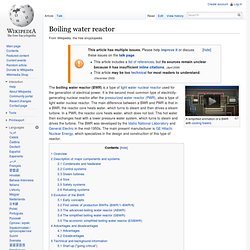
It is the second most common type of electricity-generating nuclear reactor after the pressurized water reactor (PWR), also a type of light water nuclear reactor. The main difference between a BWR and PWR is that in a BWR, the reactor core heats water, which turns to steam and then drives a steam turbine. In a PWR, the reactor core heats water, which does not boil. This hot water then exchanges heat with a lower pressure water system, which turns to steam and drives the turbine. The BWR was developed by the Idaho National Laboratory and General Electric in the mid-1950s. Overview[edit] BWR schematic. Description of major components and systems[edit] Condensate and feedwater[edit]
Pool-type reactor - Wiki. The control room of NC State's Pulstar Nuclear Reactor.
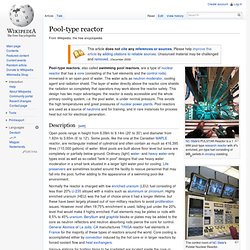
Pool-type reactors, also called swimming pool reactors, are a type of nuclear reactor that has a core (consisting of the fuel elements and the control rods) immersed in an open pool of water. The water acts as neutron moderator, cooling agent and radiation shield. The layer of water directly above the reactor core shields the radiation so completely that operators may work above the reactor safely. This design has two major advantages: the reactor is easily accessible and the whole primary cooling system, i.e. the pool water, is under normal pressure. This avoids the high temperatures and great pressures of nuclear power plants. Description[edit] Open pools range in height from 6.09m to 9.14m (20' to 30') and diameter from 1.82m to 3.65m (6' to 12').
Normally the reactor is charged with low enriched uranium (LEU) fuel consisting of less than 20% U-235 alloyed with a matrix such as aluminium or zirconium. Nuclear power plant - Wiki. This article is about electricity generation from nuclear power.

For the general topic of nuclear power, see Nuclear power. A nuclear power plant is a thermal power station in which the heat source is a nuclear reactor. As is typical in all conventional thermal power stations the heat is used to generate steam which drives a steam turbine connected to an electric generator which produces electricity. As of 23 April 2014[update], the IAEA report there are 435 nuclear power reactors in operation[1] operating in 31 countries.[2] Nuclear power plants are usually considered to be base load stations, since fuel is a small part of the cost of production.[3] History[edit] The control room at an American nuclear power plant.
Fast-neutron reactor - Wiki. Shevchenko BN350 nuclear fast reactor and desalination plant situated on the shore of the Caspian Sea.

The plant generated 135 MWe and provided steam for an associated desalination plant. View of the interior of the reactor hall. A fast neutron reactor or simply a fast reactor is a category of nuclear reactor in which the fission chain reaction is sustained by fast neutrons. Such a reactor needs no neutron moderator, but must use fuel that is relatively rich in fissile material when compared to that required for a thermal reactor. Introduction[edit] Neutrons released in fission events typically have energies greater than 1 MeV. Advantages[edit] Although it is currently (2010) uneconomic,[6] a fast neutron reactor can reduce the total radiotoxicity of nuclear waste, and dramatically reduce the waste's lifetime.[7] They can also use all or almost all of the fuel in the waste.
Light water reactor - Wiki. A simple light water reactor The light water reactor (LWR) is a type of thermal-neutron reactor that uses normal water, as opposed to heavy water, as both its coolant and neutron moderator – furthermore a solid form of fissile elements is used as fuel.

Thermal-neutron reactors are the most common type of nuclear reactor, and light water reactors are the most common type of thermal-neutron reactor. There are three varieties of light water reactors: the pressurized water reactor (PWR), the boiling water reactor (BWR), and (most designs of) the supercritical water reactor (SCWR). History[edit] Early concepts and experiments[edit] After the discoveries of fission, moderation and of the theoretical possibility of a nuclear chain reaction, early experimental results rapidly showed that natural uranium could only undergo a sustained chain reaction using graphite or heavy water as a moderator. Advanced gas-cooled reactor - Wiki. An advanced gas-cooled reactor (AGR) is a type of nuclear reactor.
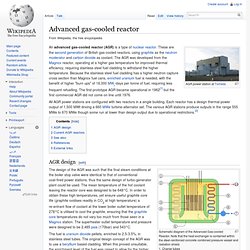
These are the second generation of British gas-cooled reactors, using graphite as the neutron moderator and carbon dioxide as coolant. The AGR was developed from the Magnox reactor, operating at a higher gas temperature for improved thermal efficiency, requiring stainless steel fuel cladding to withstand the higher temperature. Because the stainless steel fuel cladding has a higher neutron capture cross section than Magnox fuel cans, enriched uranium fuel is needed, with the benefit of higher "burn ups" of 18,000 MWt-days per tonne of fuel, requiring less frequent refuelling.
The first prototype AGR became operational in 1962[1] but the first commercial AGR did not come on line until 1976. All AGR power stations are configured with two reactors in a single building. AGR design[edit] Nuclear reactor physics - Wiki. Sodium - Wiki. Sodium is a chemical element with the symbol Na (from Latin: natrium) and atomic number 11.

It is a soft, silver-white, highly reactive metal and is a member of the alkali metals; its only stable isotope is 23Na. The free metal does not occur in nature, but instead must be prepared from its compounds; it was first isolated by Humphry Davy in 1807 by the electrolysis of sodium hydroxide. Sodium is the sixth most abundant element in the Earth's crust, and exists in numerous minerals such as feldspars, sodalite and rock salt (NaCl).
Many salts of sodium are highly water-soluble, and their sodium has been leached by the action of water so that sodium and chlorine (Cl) are the most common dissolved elements by weight in the Earth's bodies of oceanic water. Many sodium compounds are useful, such as sodium hydroxide (lye) for soap-making, and sodium chloride for use as a de-icing agent and a nutrient (edible salt). Characteristics Physical. Boiling water reactor. Pool-Type Reactor - Wiki.
Nuclear Reactor - Wiki. This article is a subarticle of Nuclear power.
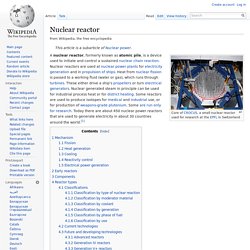
Core of CROCUS, a small nuclear reactor used for research at the EPFL in Switzerland A nuclear reactor, formerly known as atomic pile, is a device used to initiate and control a sustained nuclear chain reaction. Nuclear reactors are used at nuclear power plants for electricity generation and in propulsion of ships. Heat from nuclear fission is passed to a working fluid (water or gas), which runs through turbines. These either drive a ship's propellers or turn electrical generators. Mechanism[edit] An induced nuclear fission event. Just as conventional power-stations generate electricity by harnessing the thermal energy released from burning fossil fuels, nuclear reactors convert the energy released by controlled nuclear fission into thermal energy for further conversion to mechanical or electrical forms.
Fission[edit] When a large fissile atomic nucleus such as uranium-235 or plutonium-239 absorbs a neutron, it may undergo nuclear fission. Nuclear power plant - Wiki. Nuclear reactor types - Search results. List of nuclear reactors - Wiki. ZEEP - Wiki. The ZEEP (Zero Energy Experimental Pile) reactor was a nuclear reactor built at the Chalk River Laboratories near Chalk River, Ontario, Canada (which superseded the Montreal Laboratory for nuclear research in Canada).
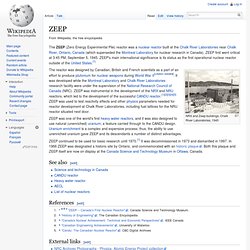
ZEEP first went critical at 3:45 PM, September 5, 1945. ZEEP's main international significance is its status as the first operational nuclear reactor outside of the United States.[1] NRX and Zeep buildings, Chalk River Laboratories, 1945 The reactor was designed by Canadian, British and French scientists as a part of an effort to produce plutonium for nuclear weapons during World War II[citation needed]. It was developed while the Montreal Laboratory and Chalk River Laboratories research facility were under the supervision of the National Research Council of Canada (NRC). ZEEP was one of the world's first heavy water reactors, and it was also designed to use natural (unenriched) uranium; a feature carried through to the CANDU design.
CANDU Reactor - Wiki. The CANDU (short for CANada Deuterium Uranium) reactor is a Canadian-invented, pressurized heavy water reactor.

The acronym refers to its deuterium-oxide (heavy water) moderator and its use of (originally, natural) uranium fuel. CANDU reactors were first developed in the late 1950s and 1960s by a partnership between Atomic Energy of Canada Limited (AECL), the Hydro-Electric Power Commission of Ontario (now Ontario Power Generation), Canadian General Electric (now GE Canada), and other companies. All power reactors built in Canada are of the CANDU type. The reactor is also marketed abroad and there are CANDU-type units operating in India, Pakistan, Argentina, South Korea, Romania and China. In October 2011, the Canadian Federal Government licensed the CANDU design to Candu Energy (a wholly owned subsidiary of SNC-Lavalin), which also acquired the former reactor development and marketing division of AECL at that time.
Design[edit] Basic design and operation[edit] Safety features[edit]